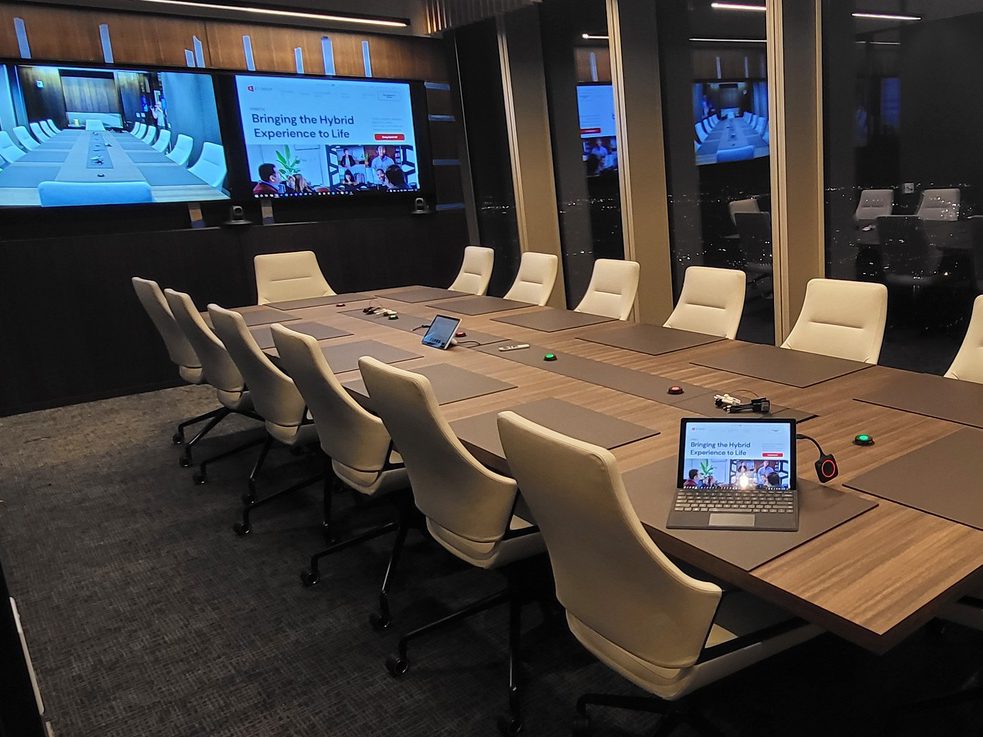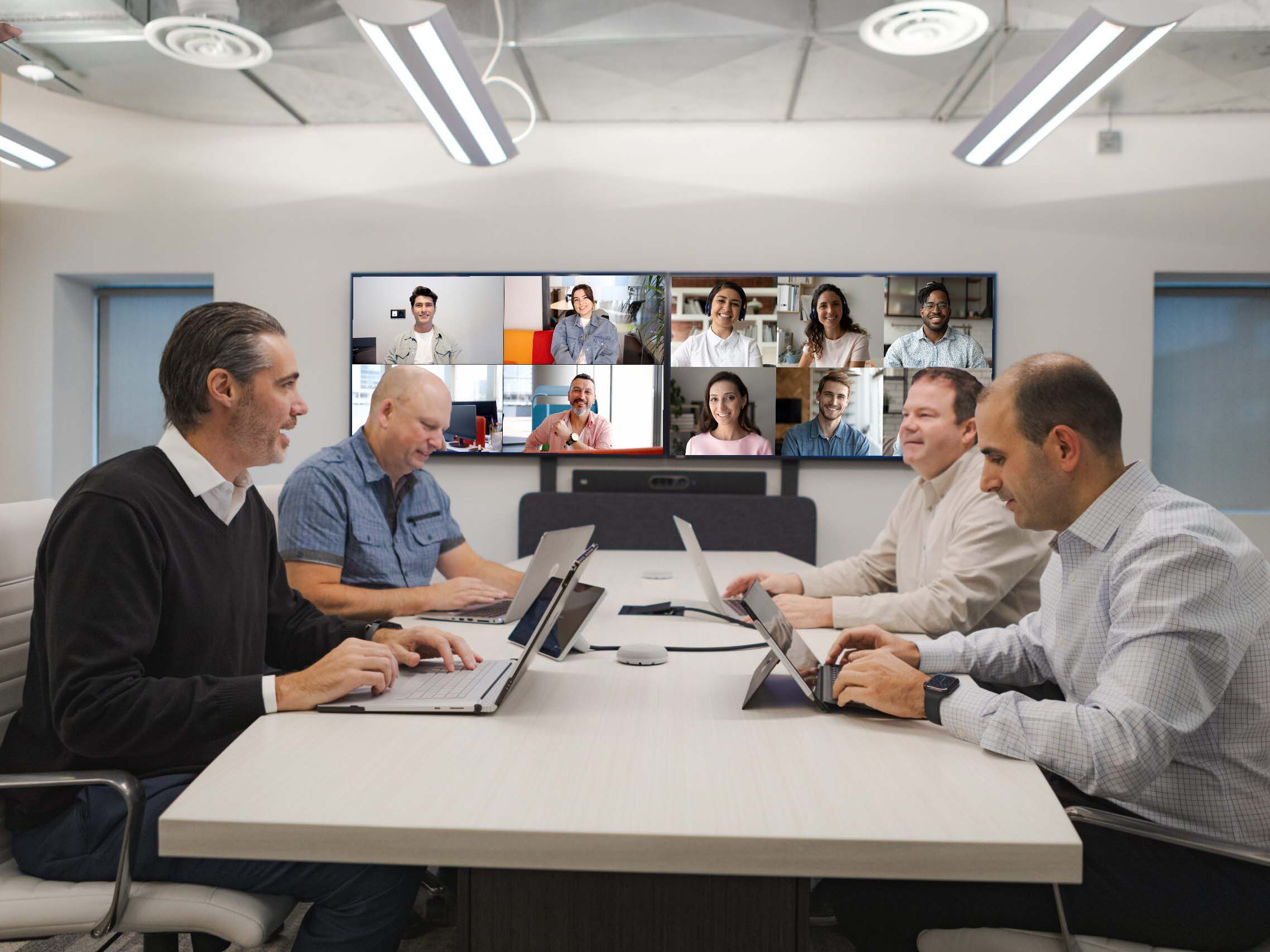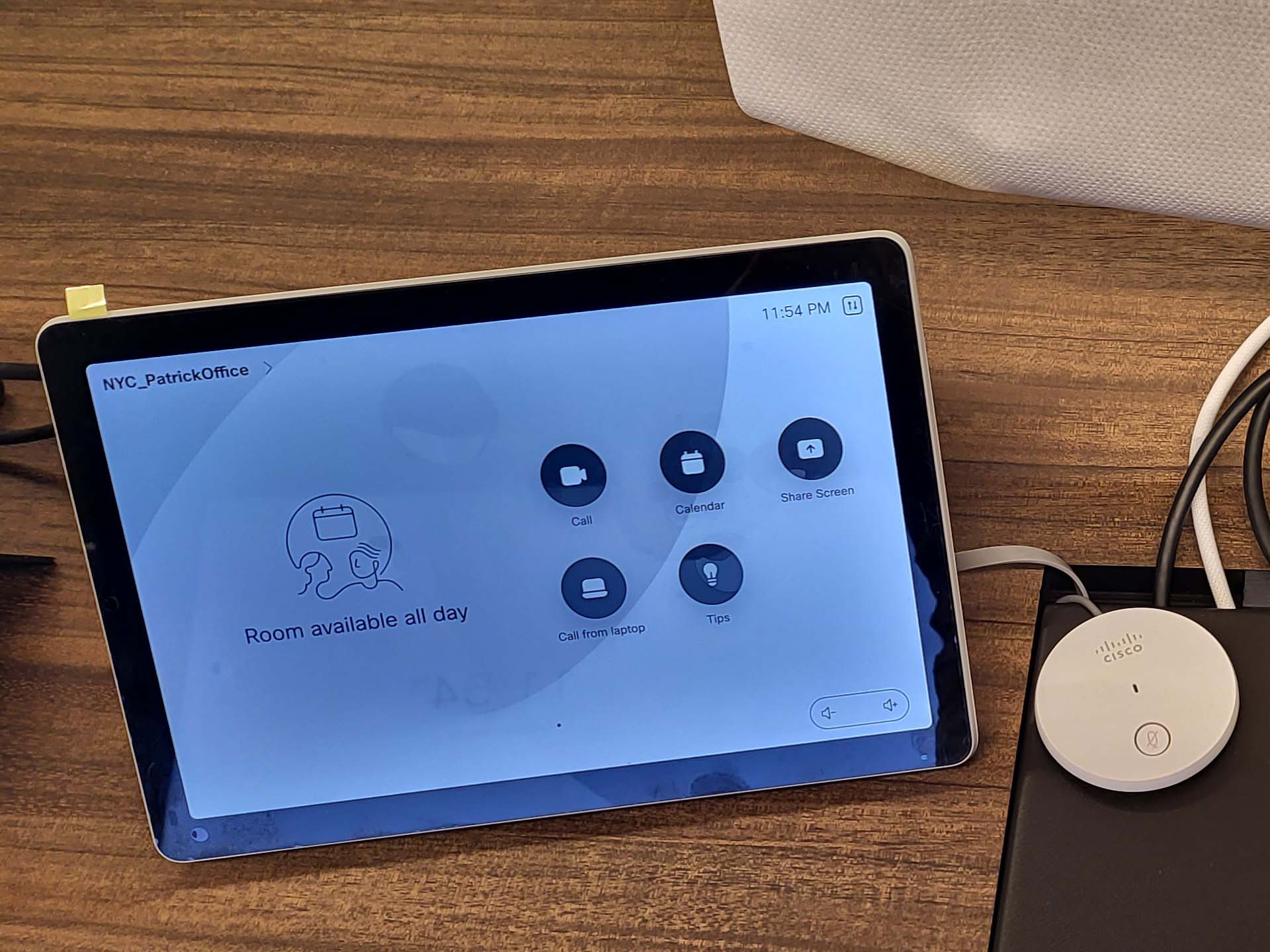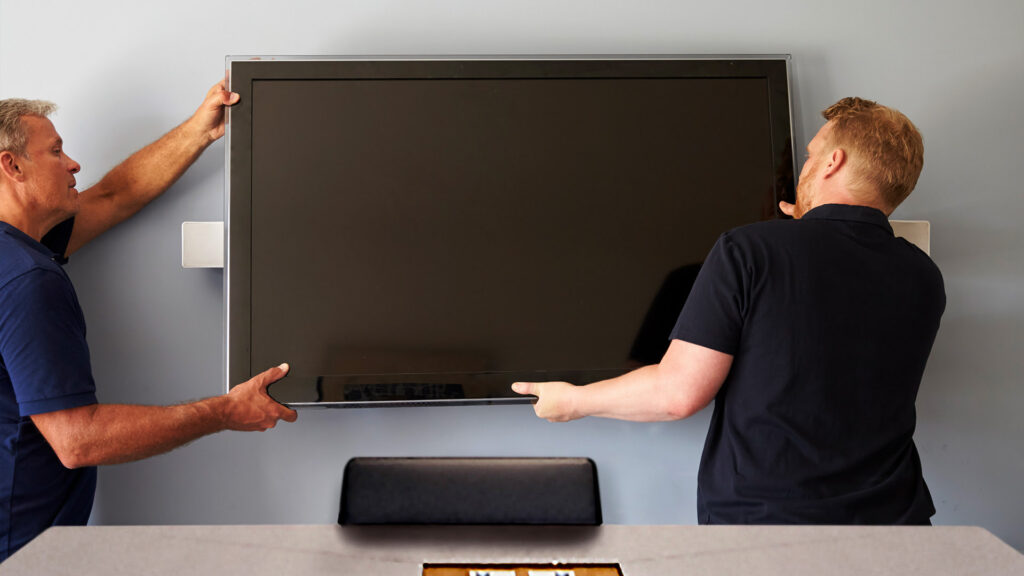The Top Conference Room AV Solutions for 2025
Summary:
- Advancements in the audiovisual space are making conference rooms smarter, more interactive, and more accessible. Trends like AI, 8k displays, advanced cameras, microphones, and sound systems are more user-friendly than ever before.
- AI-powered features built into Cisco’s Board Pro G2 and Crestron’s Automated VX make tasks like automation, camera tracking, collaboration easier for hybrid teams. They also provide real-time feedback to help you optimize rooms.
- New 5K ultra-HD displays, like Jupiter’s Pana series and Sharp’s NEC M-Series, make conferences more exciting and alive by preserving details so participants feel more present.
- Microphones, cameras, and speakers are pushing to deliver cleaner, clearer video and audio feeds so that presentations feel more professional and impactful. This helps teams get the right message across without distractions.
- Support for hybrid work is expected to keep growing over the next 12 months. The ability to connect to conference room tech from anywhere is now a standard feature that helps remote workers feel more included.
Imagine walking into a conference room that instantly springs to life and adapts to your individual needs—a uniquely designed space customized to your business and workflows. AI seamlessly automates tasks like note-taking, data-collection, and real-time captions behind the scenes without the need for constant oversight.
To join or host a meeting, all you have to do is click a button. You can control the system with voice commands or hand gestures, and ultra-HD displays make conferencing calls feel as if you’re standing right next to the other person.
These innovations are already here. From advancements in audiovisual hardware to AI-powered features that automate tedious but important tasks, conference room tech is evolving in a big way. In this guide, we’ll tell you about the cutting-edge solutions that can help you stay ahead of the curve.

Audiovisual Trends for Better Communication in 2025
Advancements in AV tech over the past few years are changing how, when, and where people work. It’s easier than ever for teams to collaborate, communicate, and work together from any location around the globe.
From AI integrations to ultra-sharp 8K displays, one-click join buttons, and touchless operation features, conference rooms are becoming more user-friendly and engaging than ever before. Here are the trends that will make hybrid work environments even better in 2025.
AI Integration
AI is a gamechanger for workplaces and meeting spaces. In 2025, we’re expecting to see an explosion in AI-powered systems that work quietly in the background to automate mundane but important tasks. Options like these will eventually become standard:
- Real-time Transcription and Translation Tools can instantly transcribe meetings as they happen or translate conversations across multiple languages, breaking down language barriers. Participants, including the speaker, stay focused on the message.
- Intelligent Camera Tracking automates the process of tracking movement and switching focus when speakers change. This makes it easier for participants to follow the flow of conversation or understand what’s happening during presentations.
- Automated Meeting Summaries ensure no important detail slips through the cracks after a conference ends. Some new platforms can also interpret and highlight key points, like names, tasks, or goals, in real-time.
- Touchless Controls: AI-powered meeting technology allows hosts and participants to interact with conference room equipment from anywhere. Gesture controls and voice commands let people manage presentations, adjust settings, and use tools hands-free.
With AI helping behind the scenes, teams can focus on what matters: connecting, collaborating, and getting the right information to the people who need it most.
New-to-Market Displays
This is a great year to up your audiovisual game with new-to-market displays that make every detail on the screen feel alive and present. From video walls to conferencing screens and touchscreen interfaces, screens are becoming more immersive, user-friendly, and intuitive.
Display Trends
- 8K displays take image quality to the next level with nearly four times the pixel density of 4k for unparalleled clarity. Video feeds come through with exceptional depth and realism that keeps participants engaged and focused.
- Higher-resolution screens make remote call participants appear more lifelike on the screen, preserving the face-to-face dynamic even when working remotely. It’s easier to detect shifts in expression or body language.
- Increased pixel densities make shared documents, designs, and data charts pop and are easier to see, even from across large rooms. Teams can collaborate more effectively without needing to pause or ask for clarification.
- 8K resolution prevents the kind of image degradation associated with scaling issues on large-format displays. Visuals stay razor-sharp without appearing blurry or distorted.
We’re also seeing more 4k and 8k displays that come with touchscreen and multi-touch compatibility built in right out of the box. Teams can use features like these to collaborate on a virtual whiteboard, brainstorm ideas, plan marketing campaigns, or show clients the content they need to see before moving forward on an important deal.
Best In Displays: Jupiter’s Pana 21:9 LCDs
Jupiter’s Pana 21:9 5K visual form factor LCDs are a prime example of how displays can be better tailored for easier communication and collaboration without sacrificing beautiful views. First developed in 2020, the ultra-wide design and and exceptional image clarity makes this line a perfect fit for modern boardrooms and hybrid work environments.
The Pana line is available in five distinct models.
| Model | Features |
| Pana 105 |
|
| Pana 81 |
|
| Pana X |
|
| Pana 34 |
|
Product Spotlight: Sharp’s NEC (M series)
Sharp’s NEC M-Series displays were already pretty forward-thinking, but now, the company is taking the whole design concept to a new level. The new NEC MultiSync® M751 and NEC MultiSync® M861 have been reworked with meeting spaces in mind.
The first obvious change is that Sharp’s NEC displays have grown in size, but they’re also getting smarter, too. Features like secure remote control via NaviSet Administrator 2 and more flexible options for integration with AV infrastructure provide future-proofing.
| Model | Features |
| NEC MultiSync® M751 |
|
| NEC MultiSync® M861 |
|
Key Features to Look for in 2025
The top solutions for 2025 don’t just provide a high-quality audiovisual experience. They’re also compatible with cutting-edge features designed to streamline teamwork, communication, and collaboration in hybrid spaces.
- Interactivity: Look for large-format 8k displays that can be integrated with or linked to existing collaboration tools for a seamless experience. Team members should be able to annotate, edit, or share documents in real-time without needing to switch screens.
- Interoperability: Single-interface systems make it easier to host video conferences, share files, and send messages. Look for meeting tech that seamlessly integrates with existing platforms like Microsoft Teams, Zoom, or WebEx. Learn more about why interoperability matters in hybrid spaces.
- Cloud-Based Collaboration: Cloud integration ensures real-time updates to shared documents, designs, and data, regardless of where people dial in from. That’s a critical feature for hybrid teams that need immediate access to the latest information.
- Wireless Participation: Participants should be able to instantly share screens from within the conference room or from their laptops and mobile devices. Look for systems that have Bluetooth, Wi-Fi, and remote connection capabilities built-in.
- Augmented Reality (AR) and Virtual Reality (VR): Collaboration tools with built-in AR or VR can turn meeting spaces into immersive 3D showrooms. These technologies let businesses create 3D environments like product walkthroughs or virtual events.
Although features like these do make conference rooms more fun and engaging to use, they’re more than just fancy bells and whistles. These tools play a crucial role in streamlining the collaboration process, especially for hybrid teams.
Best In Interoperability Solutions
Adaptability in video conferencing and meeting solutions will become more important than ever in 2025. Pexip Connect and Synergy Sky are first out of the gate with new features that prioritize the growing need for reliable, integrated, and secure meeting tech.
Product Spotlight: Pexip
Pexip Connect’s ability to integrate seamlessly with multiple video conferencing platforms like Microsoft Teams, Zoom, and Google Meet is unparalleled. Yet, it’s also completely device agnostic, meaning that participants can connected to the system securely from anywhere.
| Integration | Microsoft Teams, Zoom, Google Meet |
| Device Support | Any device or room system |
| Security | End-to-end encryption, private cloud deployment |
| Analytics | Not specified |
| Special Features | No extra hardware required |
Product Spotlight: Synergy Sky
Synergy SKY is a video conferencing platform that takes the idea of everyday meetings and collaboration sessions to the next level. Features go beyond just reliable video streaming—SKY can also optimize room usage, simplify scheduling, and provide metrics to help you monitor how people use your meeting spaces.
| Integration | Microsoft Teams, Webex, Zoom |
| Device Support | Multiple video conferencing systems |
| Security | Hybrid collaboration with device management |
| Analytics | Provides detailed room performance and meeting metrics |
| Special Features | Streamlined scheduling and room usage optimization |
Best In Interactive Meeting Boards
Interactive meeting boards are evolving to make it easier for teams to work more effectively, whether in-person or remote. These advanced tools integrate video conferencing, touch screen interactivity, and seamless platform compatibility all into one neat little package.
Product Spotlight: Microsoft Surface Hub 3
The Surface Hub 3 is an all-in-one solution from Microsoft that was originally designed to integrate with Microsoft Teams. Available in two sizes, this tidy little tool serves as a collaborative canvas and comes with flexible, modular accessories, including pens and Microsoft’s Surface Hub Smart Camera.
| Screen Sizes | 50”, 85” |
| Collaboration Tools | Microsoft Whiteboard, Microsoft Teams, OneNote integration |
| Operating System | Windows 11 Team Edition |
| Touch Support | Supports multi-touch and pen input |
| Special Features |
|
Product Spotlight: Cisco Board Pro G2
The Cisco Board Pro G2 is an integrated video device and collaboration board that’s available in two sizes, 55″ and 75″. It’s designed specifically with hybrid meeting environments in mind. AI-enhanced cinematic views make details feel alive and present—and help participants stay focused, too. This is a great option if you want multiple camera views and easy interoperability.
| Screen Sizes | 55”, 75” |
| Camera Views | Frames, People Focus, Adaptive Speaker, Optimized Group |
| Collaboration Tools | Webex Whiteboard, Webex Meetings, content sharing |
| Integration Options | External PTZ camera, existing AV infrastructure |
| Touch Support | Multi-touch, stylus-enabled |
| Operating System | Webex OS |
| Chipset | NVIDIA® AI |
| Mounting Options | Floor, Wall, Wheels |
| Additional Features |
|
Best in Control Panels: Cisco Room Navigator
Cisco Room Navigator stands out for 2025 thanks to its inherent ability to streamline the meeting experience, right from initial scheduling to room optimization. Features like LED lights built into wall-mounted touch panels signal real-time workspace availability, but also make these devices ideal for wayfinding and digital signage.
| Screen Size | 10” touchscreen with multicolor 360° LED |
| POE Enabled? | Yes |
| Resolution | 1920×1200 |
| Operating System | CISCO RoomOS |
| Cloud Management | Unified admin, device management, analytics, and workspace insights via Control Hub |
| Interoperability | Native or third-party integration via Cisco’s APIs |
Must-Have Hardware
Your conference room hardware plays an important role in overall user experience. Old or outdated hardware can prevent you from fully leveraging advanced technologies like HD screens and AI. Here’s what’s most important to keep up to date.
Microphones
Generally speaking, ceiling-mounted omnidirectional microphones with speaker tracking are best for large spaces. Table-mounted boundary microphones may be a better choice for small conference rooms and events with multiple speakers.
In terms of specifications, look for:
-
- Frequency Response: 20 Hz to 20 kHz is best for capturing voices.
- Signal-to-Noise Ratio (SNR): > 70 dB helps distinguish voices from distractions.
- Connectivity Options: USB, XLR, Bluetooth, or Dante work best for meeting spaces.
- Audio processing: Noise cancellation and echo reduction helps reduce interference.
- Automatic Gain Control (AGC): This feature keeps volume levels consistent.
- Beamforming Technology: Beamforming automatically tracks speakers as they move.
Your microphone’s pickup pattern also matters. Unidirectional devices only record audio from a specific direction, making them ideal for podiums. Bidirectional microphones capture voices from at least two directions, while omnidirectional devices provide 360° coverage instead.
Cameras
The quality of your video input is just as important as the output. If your cameras can’t capture high-resolution video in the first place, even the newest cutting-edge 8K displays won’t deliver to their full potential. For the best experience, invest in cameras that support 4k to 8k resolutions.
Other desirable specs for conference rooms include:
- Field of view (FOV): 90° to 120° is ideal for small rooms and huddle spaces.
- Adjustable FOV: For larger conference rooms, look for an adjustable FOV instead.
- Frame Rates: 30 to 60 Frames Per Second (FPS) delivers smoother, more lifelike video.
- Auto-Framing: AI intelligently adjusts focus and framing for better composition.
Features like these can make video feeds feel more immersive and exciting for users. They’re also better at capturing facial expressions, body language, and emotional cues, preserving the face-to-face dynamic during video calls.
Speakers
Clear, natural sound reproduction can make or break your conference room experience. With the right system, it’s possible to turn your meeting space into an immersive 3D soundscape filled with rich audio without distortion or feedback.
Here’s what specifications you should look for:
-
- Frequency Range: Look for 50 Hz to 20 kHz to preserve deep bass and clear treble.
- Wattage: Scale up from a minimum of 20W to 100W+ depending on room size.
- Sensitivity: Aim for a Sound Pressure Level (SPL) of >85 dB for clearer audio.
- Impedance: 8 ohms is sufficient for most conference rooms.
Speaker position and placement are also important. For the most optimized sound experience, it’s best to have your conference room custom designed to account for unique acoustics.
We recommend ceiling-mounted speakers for larger spaces or surround sound setups. Smaller tabletop speaker systems are a nice compromise if space is at a premium.
Best in Mics and Speakers
In 2025, advanced microphones and speakers are pivotal for creating high-quality, immersive audio experiences in hybrid workspaces. Biamp and Sennheiser lead the charge with cutting-edge audio technology that ensures clarity and adaptability.
Product Spotlight: Sennheiser TeamConnect Ceiling Mics
The Sennheiser TeamConnect Ceiling Mic is a highly innovative microphone designed for scalable, seamless audio. It adapts to dynamic room layouts, offering flexible, clear sound capture from any direction.
| Microphone Type | Ceiling-mounted microphone array |
| Audio Technology | Adaptive beamforming for 360° coverage |
| Use Case | Best for flexible meeting rooms and large spaces |
| Special Features |
|
Product Spotlight: Crestron Automate VX
To be clear, Crestron’s Automate VX isn’t new camera tech—but it’s going to become just as important for meeting spaces and board rooms over the next year. This is an AI-driven automated camera tracking solution that seamlessly switches focus as speakers change.
Automate VX can be integrated with your existing AV infrastructure and controlled with only voice and natural movement. While you can create custom views, most of the magic happens in the background silently without the need for any input.
- Voice-Activated Camera Switching ensures cameras switch focus as speakers change, move around the room, or drop out of the conversation.
- Conversation Mode lets all participants see everyone else on the call at once, ensuring that even the most minor cues aren’t missed.
- Interoperability Options support integration with almost any system, platform, or device, including Microsoft Teams and Zoom.
Pair Automate VX with Crestron’s Automate VX Pro System or 1 Beyond Cameras to gain access to additional features like built-in visual AI, 12 camera feed maximums and output to your video conferencing platform of choice.
Related: 10 Ways You Can Nail Your Conference & Video Meeting Rooms

Hybrid Work Compatibility is Critical
Whether you’re on a tight budget or planning to develop the most bleeding-edge conference room in your industry, designing your meeting spaces to be compatible with hybrid work environments is no longer just an option. Teams and clients need access to meeting and collaboration tech that makes it easy to join, host, or take control seamlessly from anywhere—including their own devices.
To make meeting spaces more hybrid work appropriate, meeting tech should be so tightly integrated that all communication and collaboration feels like it happens within a single unified platform. This includes email, instant messaging, voice and video calls.
Features like one-touch dial, AI-driven automation, and intelligent camera framing support hybrid work environments, but they also save time, making meetings more efficient. Participants can focus on big ideas and innovation instead of taking notes, following up, or struggling with technical difficulties.
When team members can jump onto a call, socialize, ask questions, or brainstorm together in seconds, they are less likely to begin to feel isolated from the office or their coworkers over time. Work environments become more human-centric and inclusive—and that’s better for everyone.
Related: 3 Ways that Unified Communication and Collaboration (UCC) Can Elevate the Meeting Experience
ET Group Can Help You Stay Ahead of the Curve
Teams work best when technology works for them, not against them. Every interaction within your conference room should feel effortless and easy, rather than frustrating or limiting.
Groundbreaking changes in audiovisual tech are already helping businesses transform the way they communicate, collaborate, and innovate. Want to get ahead of the curve? You’re in the right place! ET Group can help you bring people, spaces and technology together in new ways that put the needs of your people first. Book a discovery call with our team to learn more.
Frequently Asked Questions about AV Solutions
What is Unified Communication and Collaboration (UCC)?
Unified Communication and Collaboration (UCC) refers to the strategic integration of technology and tools that streamline how people work together remotely and on-site. UC&C designs focus on combining elements like email, messaging, video, remote whiteboards, and other collaboration tools in ways that make them feel as if they exist within one unified system.
More businesses are adopting hybrid work environments every day, which is exactly why it’s so important to have access to spaces that prioritize UCC. ET Group can help you get up to speed and make the most of UCC for a more connected, efficient, and versatile workplace.
I need help with my meeting tech. Who can I call?
If you have a pre-existing relationship with ET group, you can reach us by telephone at +1 (855) 509-5491 during the office hours listed in your service-level agreement (SLA). Or, if it’s easier, send in a help desk ticket.
If you don’t have an existing relationship with us or your meeting tech was installed by another company, and you’re ready for a change, we want to help. Reach out to our sales team for a free consultation or discovery call.
Does ET Group design large-scale conference spaces?
Yes! Audiovisual quality and seamless interoperability are crucial in large spaces, where maintaining focus and engagement can be challenging. We have access to solutions like video walls, ultra-wide form factor displays, ceiling-mounted speaker systems, and noise-cancelling microphones with AI-driven speaker tracking.
Book a consultation to find how we can help your teams keep the focus on important details, rather than background noise or interruptions.
What is a “human-centric” room design?
When we say a room design is “human-centric,” it prioritizes the needs, goals, behaviors, and experiences of the teams or people who interact with that space. It’s important for meeting rooms to provide access to the right level of technology—no more, no less.
Systems that leave people feeling frustrated or dreading the thought of another meeting don’t help teams thrive. In fact, they often stifle innovation and hamper communication. Learn more about human-centric design for hybrid spaces here.
Stay connected with us:
Follow ET Group on LinkedIn
Subscribe to ET Group’s YouTube Channel







